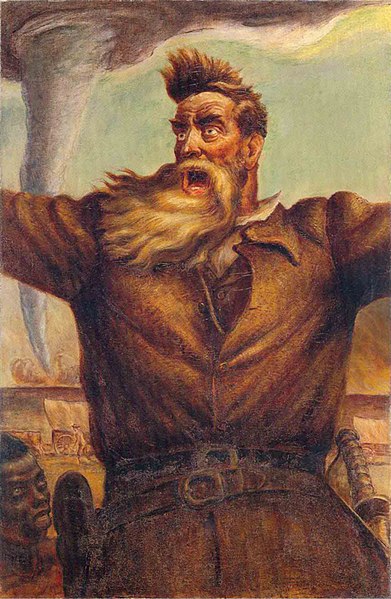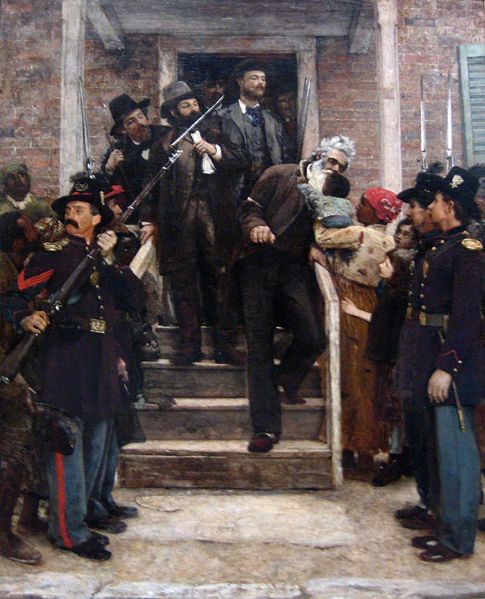John Brown (1800-1859) was a 19th-century American abolitionist known for his passionate and militant opposition to slavery. Born in Connecticut, he became deeply committed to the anti-slavery cause while living in Massachusetts.
Brown’s involvement in the violent “Bleeding Kansas” conflicts and his infamous raid on Harpers Ferry, Virginia, aimed at inciting a slave rebellion, solidified his reputation as a radical abolitionist.
Captured, tried, and executed in 1859, Brown’s willingness to die for his beliefs made him a martyr for the abolitionist movement.
His actions and ideals contributed to the escalating tensions that led to the American Civil War and ultimately played a role in the abolition of slavery in the United States.
| Year | Event |
|---|---|
| May 9, 1800 | John Brown is born in Torrington, Connecticut. |
| 1837 | John Brown moves to Springfield, Massachusetts, and becomes involved in the anti-slavery movement. |
| 1851 | John Brown’s family is attacked by pro-slavery supporters in Kansas. |
| May 24, 1856 | John Brown and his sons carry out the “Pottawatomie massacre” in Kansas. |
| August 30, 1856 | John Brown and his followers defend Osawatomie, Kansas, in the Battle of Osawatomie. |
| October 16, 1859 | John Brown leads a raid on Harpers Ferry, Virginia, with the aim of sparking a slave revolt. |
| October 18, 1859 | John Brown is put on trial for treason, murder, and conspiracy in Virginia. |
| December 2, 1859 | John Brown is found guilty and sentenced to death. |
| December 2, 1859 | John Brown is executed by hanging in Charles Town, Virginia. |
| 1863 | The Emancipation Proclamation is issued by President Abraham Lincoln, partially fulfilling one of John Brown’s goals. |
| 1859-1865 | The American Civil War takes place, with the issue of slavery at its core. |
| Late 19th century | John Brown’s actions and sacrifice for the abolitionist cause lead to his being celebrated as a martyr and hero by some and condemned as a terrorist by others. |
Timeline of John Brown
1800: John Brown is born in Torrington, Connecticut
John Brown, the famous abolitionist and militant, was born on May 9, 1800, in Torrington, Connecticut. He was raised in a devoutly religious family with strong anti-slavery beliefs.
Brown’s upbringing instilled in him a deep sense of moral conviction and a commitment to fighting against the institution of slavery.

1837: John Brown moves to Springfield, Massachusetts, and becomes involved in the anti-slavery movement
In 1837, John Brown relocated to Springfield, Massachusetts, where he actively immersed himself in the burgeoning anti-slavery movement.
During this time, the United States was increasingly divided over the issue of slavery, and tensions were escalating. Brown’s involvement in the movement marked the beginning of his lifelong dedication to the abolitionist cause.
In Springfield, Brown associated with prominent abolitionists and became deeply committed to the cause of ending slavery. He believed that slavery was a grave sin and that armed resistance might be necessary to achieve its abolition.
1851: John Brown’s family is attacked by pro-slavery supporters in Kansas
In the early 1850s, the debate over whether Kansas would enter the Union as a free state or a slave state intensified, leading to a period known as “Bleeding Kansas.” Brown, along with several of his sons, decided to move to Kansas to participate in the struggle against pro-slavery forces.
In 1851, Brown’s family experienced a traumatic event when pro-slavery supporters attacked and brutally beat some of his sons during the “Sacking of Lawrence” in Kansas. This violent encounter had a profound impact on Brown, strengthening his resolve to take more direct and militant action against slavery.
The attack on his family was one of the key catalysts that led John Brown to adopt more radical methods in his fight against slavery, ultimately culminating in his involvement in violent incidents and the famous raid on Harpers Ferry in 1859.
1856: John Brown and his sons carry out the “Pottawatomie massacre” in Kansas
In retaliation for the attack on his family during the “Sacking of Lawrence” in Kansas in 1851 and as a response to the escalating violence in “Bleeding Kansas,” John Brown and his sons committed a brutal act known as the “Pottawatomie massacre” in May 1856.
Under Brown’s leadership, they killed five pro-slavery settlers in Pottawatomie Creek, Kansas, as a means of avenging anti-slavery supporters who had been killed.
This violent act shocked the nation and deepened the divide between pro-slavery and anti-slavery forces in Kansas. It marked a significant turning point in Brown’s tactics, as he increasingly believed that armed resistance was necessary to combat slavery.

1856: John Brown and his followers defend Osawatomie, Kansas, in the Battle of Osawatomie
As the conflict in Kansas continued to escalate, John Brown and a group of his followers defended the free-state town of Osawatomie against a pro-slavery militia on August 30, 1856. The skirmish became known as the Battle of Osawatomie and was a violent episode in the larger struggle for control of Kansas.
Despite being outnumbered and outgunned, Brown’s determination and resolve in defending Osawatomie made him a symbol of resistance against pro-slavery forces in the territory. This battle further solidified his reputation as a militant abolitionist.
1859: John Brown leads a raid on Harpers Ferry, Virginia, with the aim of sparking a slave revolt
One of the most famous and consequential events in John Brown’s life occurred on the night of October 16, 1859, when he led a small group of men, including his sons, in a daring raid on the federal arsenal at Harpers Ferry, Virginia (now West Virginia).
Brown’s plan was to capture the weapons stored at the arsenal and incite a widespread slave rebellion in the South.
However, the raid did not go as planned. Brown and his men were unable to secure the arsenal and found themselves trapped by U.S. Marines under the command of then-Lieutenant Colonel Robert E. Lee. After a two-day standoff, Brown and his followers were captured.
The failed raid on Harpers Ferry became a major national news story and further polarized the country. Brown’s actions were seen as heroic by some abolitionists but as a dangerous and treasonous act by many in the South.
Brown was subsequently put on trial, found guilty, and sentenced to death, which elevated him to the status of a martyr for the abolitionist cause.
1859: John Brown is put on trial for treason, murder, and conspiracy in Virginia
Following the capture of John Brown and his men at Harpers Ferry, they were arrested and placed on trial. Brown faced a variety of charges, including treason against the state of Virginia, murder, and conspiracy to incite a slave rebellion.
His trial was a highly publicized event, drawing attention from both abolitionists and pro-slavery advocates.
During the trial, Brown remained unrepentant for his actions, and he saw the courtroom as an opportunity to further his abolitionist message. He used his time in court to eloquently express his anti-slavery beliefs and his willingness to die for the cause.
1859: John Brown is found guilty and sentenced to death
On December 2, 1859, John Brown was found guilty on all counts in his trial. The guilty verdict came as no surprise given the nature of his actions and the prevailing sentiment in Virginia, which was a pro-slavery state.
Brown’s sentencing was equally unsurprising. The judge sentenced him to death by hanging, and his execution was scheduled for December 2, 1859.

1859: John Brown is executed by hanging in Charles Town, Virginia
On the appointed day, December 2, 1859, John Brown was executed by hanging in Charles Town, Virginia. His execution was a solemn and widely watched event, and it stirred intense emotions across the nation.
Brown faced his execution with remarkable composure and dignity. He continued to express his unwavering commitment to the abolitionist cause, and his stoic demeanor in the face of death solidified his status as a martyr for the abolitionist movement. His willingness to die for his beliefs left a lasting impact on the nation’s consciousness.
1863: The Emancipation Proclamation is issued by President Abraham Lincoln, partially fulfilling one of John Brown’s goals
Although John Brown’s methods were controversial and radical, his ultimate goal of ending slavery gained traction in the years following his execution.
In 1863, during the American Civil War, President Abraham Lincoln issued the Emancipation Proclamation. This historic executive order declared the freedom of all enslaved people in Confederate-held territory.
While the Emancipation Proclamation did not immediately free all enslaved individuals, it marked a significant step toward the abolition of slavery in the United States. It partially fulfilled one of John Brown’s central objectives, which was the liberation of enslaved people and the dismantling of the institution of slavery.
1861-1865: The American Civil War takes place, with the issue of slavery at its core
The American Civil War, often referred to simply as the Civil War, raged on from 1861 to 1865. It was a defining period in American history and had the issue of slavery as its central cause.
The war was fought between the Northern states, known as the Union, and the Southern states, known as the Confederacy, which sought to preserve and expand the institution of slavery.
The legacy of John Brown and his militant approach to ending slavery had a profound influence on the course of the Civil War. While Brown’s actions, such as the raid on Harpers Ferry, were initially seen as extreme and divisive, they helped galvanize abolitionist sentiment in the North.
As the war progressed, the moral imperative of ending slavery became increasingly clear to many, and President Abraham Lincoln issued the Emancipation Proclamation in 1863, declaring enslaved people in Confederate territory to be free.
The Civil War ultimately resulted in the defeat of the Confederacy and the abolition of slavery through the ratification of the 13th Amendment to the U.S. Constitution in 1865.
Late 19th century: John Brown’s actions and ideals continue to be a subject of debate and admiration
In the years following the Civil War, John Brown’s legacy remained a topic of debate and discussion in the United States. His actions, which had been seen as radical and controversial during his lifetime, began to be reevaluated by historians and the public.
While some continued to view Brown as a dangerous fanatic, others saw him as a martyr and a hero who had played a pivotal role in ending slavery. His willingness to sacrifice his life for the abolitionist cause left a lasting impact on the American consciousness.
Brown’s name and deeds were invoked by subsequent generations of activists fighting for civil rights and equality. He became a symbol of resistance against oppression and a powerful figure in the ongoing struggle for justice.
